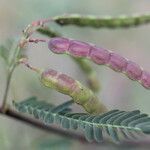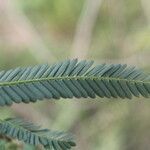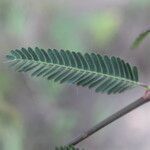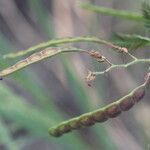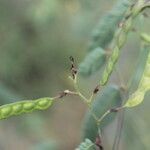Herbs to 4 m tall; stems glabrous to glabrate below, fruiting branches glabrous to moderately hispidulous with glandular trichomes. Leaves 2-10 cm long, 10-40 foliolate, petiole and rachis hispidulous; leaflets oblong, obtuse to truncate, 4-15 mm long, 1.5-3.0 mm wide, the costae central, the nerves inconspicuous, mi-nutely punctate adaxially; stipules appendiculate below the point of attachment, caducous, 5-20 mm long, 1.5-5.0 mm wide, subentire, acute to acuminate above, truncate below, erose. Inflorescence racemose, axillary, 4-8 flowered; peduncles and pedicels subglabrous to densely hispidulous; bracts stipuliform, entire to ciliate-laciniate; bracteoles ovate, subacute, 1.5-5.0 mm long, 1-2 mm wide, en-tire to ciliate. Flowers yellow, 5-6 mm long; calyx 2-4 mm long, usually ciliate, vexillar lobe emarginate or subdenticulate, the cardinal lobe obscurely 3-dentate, standard 6-8 mm long, the claw 1.5-2.0 mm long, the blade suborbiculate, 4.5-6.0 mm wide, ciliate, sometimes retuse, wings and keel subequal to the standard, the claws 0.5-1.0 mm long, blades 3.5-7.0 mm long, 2.5-3.5 mm wide; stamens 5-7 mm long. Fruit a loment, 5-8 (rarely-10) articulate, stipe 4-8 mm long, glabrous, articles 5-7 mm long, 4-7 mm wide, glabrous to sparsely hispid, smooth to verrucose, the upper margin of loment entire, the lower crenate to subentire; seeds 3-4 mm long, 2.5-3.0 mm wide, brown. Chromosomes: n = 10.
Leaves sensitive, 10–40-foliolate; leaflets 6–15 × 1–4 mm, linear-oblong, rounded but mucronulate at the apex, obliquely rounded at the base, entire, glabrous; venation obscure; petiole and rhachis together 1–6 cm long, with tubercular-based hairs; petiolules 0.5 mm long; stipules 6–16 × 1–2.5 mm, oblong-lanceolate, straight, spurred, soon falling.
Fruit stipitate, 3–4.5 cm long, linear, straight or slightly curved, (4)6–9-jointed, the suture somewhat constricted between the articles; articles 4–6 × 4–5 mm, ± oblong, compressed, very sparsely pubescent or at length glabrous, raised in the middle but smooth save for a slightly raised venation.
Inflorescences leaf-opposed, 3–7-flowered; peduncle 1–15 mm long; rhachis 1.5–8 cm long; pedicels 2–5 mm long; bracts 4–5 × 1–1.5 mm, deciduous; bracteoles 2.5–3.5 × 1.5 mm, ovate-elliptic, ciliate.
Standard yellow, often flushed purplish-red or apricot outside, 7–8 × 5–6 mm, rounded, emarginate; keel petals yellow, not laciniate.
Calyx glabrous or ciliate, 2-lipped; lips 3.5–4 × 2.5–3 mm, broadly oblong, one emarginate, the other 3-toothed at the apex.
Seeds dark chestnut-brown, shiny, compressed, 3.2 × 2.2 × 1.8 mm, oblong-ellipsoid, almost beaked at one end of the hilum.
Erect much branched sometimes slightly viscid subshrub, 1–2 m tall; mostly blackening on drying.
Stems pubescent with tubercular-based hairs or, in some areas, glabrescent.
An undershrub with slightly viscid branches
Small bright yellow flowers
